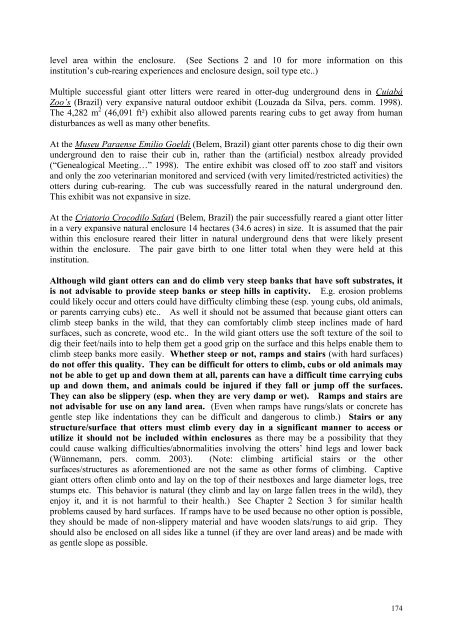International Giant Otter Studbook Husbandry and Management
International Giant Otter Studbook Husbandry and Management
International Giant Otter Studbook Husbandry and Management
Create successful ePaper yourself
Turn your PDF publications into a flip-book with our unique Google optimized e-Paper software.
level area within the enclosure. (See Sections 2 <strong>and</strong> 10 for more information on this<br />
institution’s cub-rearing experiences <strong>and</strong> enclosure design, soil type etc..)<br />
Multiple successful giant otter litters were reared in otter-dug underground dens in Cuiabá<br />
Zoo’s (Brazil) very expansive natural outdoor exhibit (Louzada da Silva, pers. comm. 1998).<br />
The 4,282 m 2 (46,091 ft²) exhibit also allowed parents rearing cubs to get away from human<br />
disturbances as well as many other benefits.<br />
At the Museu Paraense Emilio Goeldi (Belem, Brazil) giant otter parents chose to dig their own<br />
underground den to raise their cub in, rather than the (artificial) nestbox already provided<br />
(“Genealogical Meeting…” 1998). The entire exhibit was closed off to zoo staff <strong>and</strong> visitors<br />
<strong>and</strong> only the zoo veterinarian monitored <strong>and</strong> serviced (with very limited/restricted activities) the<br />
otters during cub-rearing. The cub was successfully reared in the natural underground den.<br />
This exhibit was not expansive in size.<br />
At the Criatorio Crocodilo Safari (Belem, Brazil) the pair successfully reared a giant otter litter<br />
in a very expansive natural enclosure 14 hectares (34.6 acres) in size. It is assumed that the pair<br />
within this enclosure reared their litter in natural underground dens that were likely present<br />
within the enclosure. The pair gave birth to one litter total when they were held at this<br />
institution.<br />
Although wild giant otters can <strong>and</strong> do climb very steep banks that have soft substrates, it<br />
is not advisable to provide steep banks or steep hills in captivity. E.g. erosion problems<br />
could likely occur <strong>and</strong> otters could have difficulty climbing these (esp. young cubs, old animals,<br />
or parents carrying cubs) etc.. As well it should not be assumed that because giant otters can<br />
climb steep banks in the wild, that they can comfortably climb steep inclines made of hard<br />
surfaces, such as concrete, wood etc.. In the wild giant otters use the soft texture of the soil to<br />
dig their feet/nails into to help them get a good grip on the surface <strong>and</strong> this helps enable them to<br />
climb steep banks more easily. Whether steep or not, ramps <strong>and</strong> stairs (with hard surfaces)<br />
do not offer this quality. They can be difficult for otters to climb, cubs or old animals may<br />
not be able to get up <strong>and</strong> down them at all, parents can have a difficult time carrying cubs<br />
up <strong>and</strong> down them, <strong>and</strong> animals could be injured if they fall or jump off the surfaces.<br />
They can also be slippery (esp. when they are very damp or wet). Ramps <strong>and</strong> stairs are<br />
not advisable for use on any l<strong>and</strong> area. (Even when ramps have rungs/slats or concrete has<br />
gentle step like indentations they can be difficult <strong>and</strong> dangerous to climb.) Stairs or any<br />
structure/surface that otters must climb every day in a significant manner to access or<br />
utilize it should not be included within enclosures as there may be a possibility that they<br />
could cause walking difficulties/abnormalities involving the otters’ hind legs <strong>and</strong> lower back<br />
(Wünnemann, pers. comm. 2003). (Note: climbing artificial stairs or the other<br />
surfaces/structures as aforementioned are not the same as other forms of climbing. Captive<br />
giant otters often climb onto <strong>and</strong> lay on the top of their nestboxes <strong>and</strong> large diameter logs, tree<br />
stumps etc. This behavior is natural (they climb <strong>and</strong> lay on large fallen trees in the wild), they<br />
enjoy it, <strong>and</strong> it is not harmful to their health.) See Chapter 2 Section 3 for similar health<br />
problems caused by hard surfaces. If ramps have to be used because no other option is possible,<br />
they should be made of non-slippery material <strong>and</strong> have wooden slats/rungs to aid grip. They<br />
should also be enclosed on all sides like a tunnel (if they are over l<strong>and</strong> areas) <strong>and</strong> be made with<br />
as gentle slope as possible.<br />
174

















